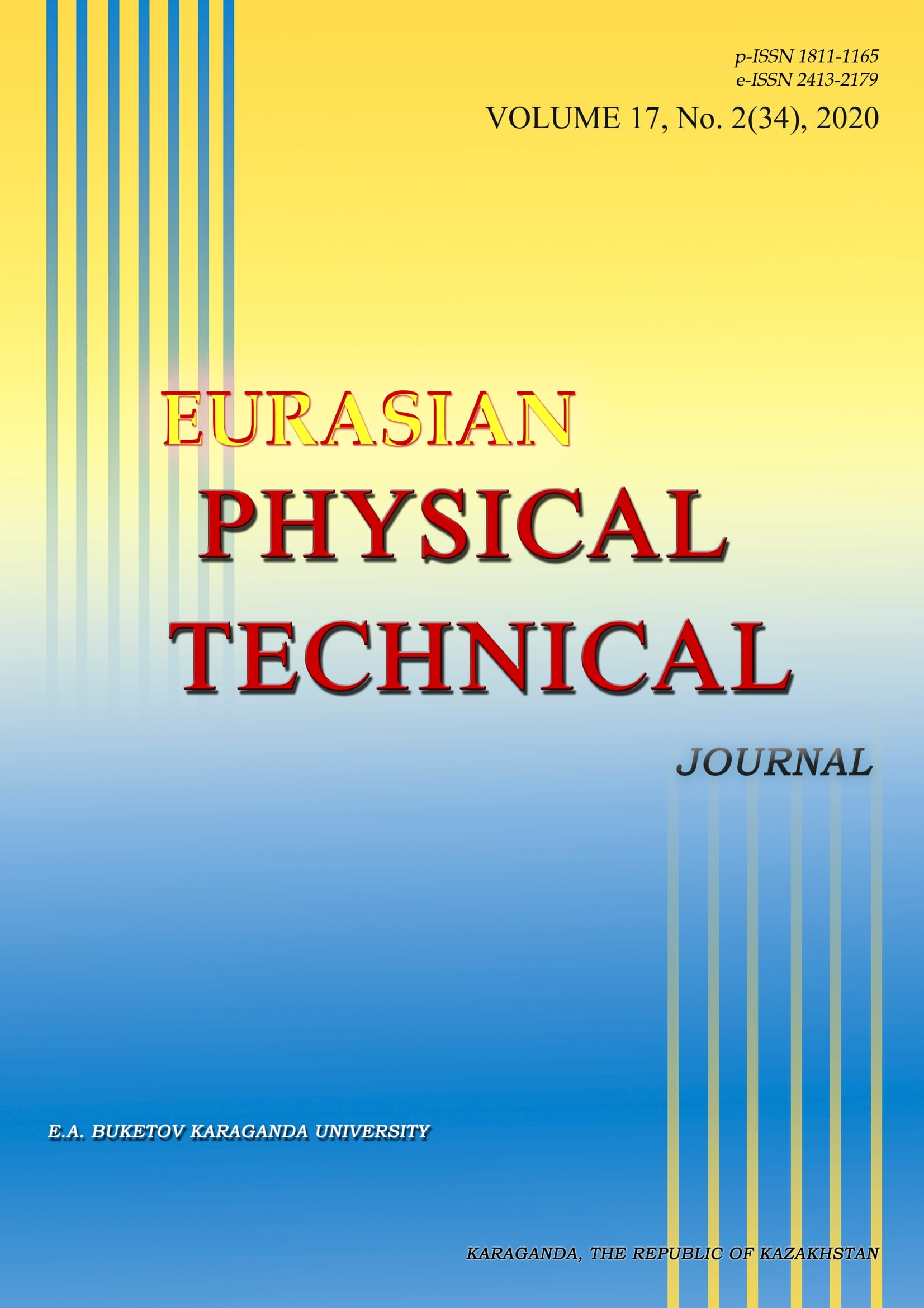HYDROPHOBIZATION OF PET TRACK-ETCHED MEMBRANES FOR DIRECT CONTACT MEMBRANE DISTILLATION OF LIQUID RADIOACTIVE WASTES
DOI:
https://doi.org/10.31489/2020No2/45-54Keywords:
UV-induced graft polymerization, track-etched membranes, direct contact membrane distillation, hydrophobization, fluorine-containing silanes, radioactive waste treatmentAbstract
This article provides the results of liquid low-level radioactive wastes treatment by direct contact membrane distillation using polyethylene terephthalate hydrophobic track-etched membranes. The hydrophobization of track-etched membranes was carried out by UV-induced graft polymerization of triethoxyvinylsilane with styrene and coating with fluorine-containing silanes. Hydrophobic membranes were investigated by scanning electron microscope, Fourier-transform infrared spectroscopy, contact anglemeasurements, and liquid entry pressure analysis. Prepared membranes were tested in treatment of liquid low-level radioactive wastes by membrane distillation. The influence of pore sizes on water flux and rejection degree was studied. Rejection degree was evaluated by conductometry and atomic emission method. Decontamination factors evaluated by gamma-ray spectroscopy for 60Co, 137Cs, and 241Am are 85.4, 1900 and 5.4 for membranes modified with polystyrene and triethoxyvinylsilanewith pore diameters of 142 nm; 85.0, 1462 and 4 for membranes modified with perfluorododecyltrichlorosilanewith pore diameters of 150 nm respectively.
References
"Zakrzewska-Trznadel G. Advances in membrane technologies for the treatment of liquid radioactive waste. Desalination.2013, Vol. 321, pp. 119–130.
Mijnendonckx K., Van Gompel A., Coninx I., Bleyen N., Leys N. Water-soluble bitumen degradation products can fuel nitrate reduction from non-radioactive bituminized waste. Appl. Geochemistry. 2020, Vol. 114, pp. 104525.
Osmanlioglu A.E. Treatment of radioactive liquid waste by sorption on natural zeolite in Turkey. J. Hazard. Mater.2006, Vol. 137, pp. 332–335.
InoueH., KagoshimaM., Yamasaki M., Honda Y. Radioactive iodine waste treatment using electrodialysis with an anion exchange paper membrane. Appl. Radiat. Isot.2004, Vol. 61, pp. 1189–1193.
AttiaH., Alexander S., Wright C.J., Hilal N. Superhydrophobic electrospun membrane for heavy metals removal by air gap membrane distillation (AGMD). Desalination.2017,Vol. 420, pp. 318–329.
Quist-Jensen C.A., Macedonio F., Horbez D., Drioli E. Reclamation of sodium sulfate from industrial wastewater by using membrane distillation and membrane crystallization.Desalination.2017, Vol. 401, pp. 112–119.
Naidu G., Jeong S., Johir M.A.H., et al. Rubidium extraction from seawater brine by an integrated membrane distillation-selective sorption system. Water Res.2017, Vol. 123, pp. 321–331.
AnA.K., Guo J., Lee E.-J., JeongS., ZhaoY., Wang Z., Leiknes T. PDMS/PVDF hybrid electrospun membrane with superhydrophobic property and drop impact dynamics for dyeing wastewater treatment using membrane distillation. J. Memb. Sci.2017, Vol. 525, pp. 57–67.
An A.K., Guo J., Jeong S., Lee E.-J., et al. High flux and antifouling properties of negatively charged membrane for dyeing wastewater treatment by membrane distillation. Water Res.2016, Vol. 103, pp. 362–371.
Shirazi M.M.A., Kargari A.,Tabatabaei M. Evaluation of commercial PTFE membranes in desalination by direct contact membrane distillation.Chem. Eng. Process. Process Intensif.2014, Vol. 76, pp. 16–25.
KhayetM. Membranes and theoretical modeling of membrane distillation: A review. Adv. Colloid Interface Sci.2011, Vol. 164, pp. 56–88.
Gancarz I., Bryjak M., Kujawski J., Wolska J., Kujawa J., KujawskiW. Plasma deposited fluorinated films on porous membranes. Mater. Chem. Phys.2015, Vol. 151, pp. 233–242.
ZdorovetsM.V., YeszhanovA.B., KorolkovI.V., GüvenO., DosmagambetovaS.S., ShlimasD.I., ZhatkanbayevaZ.K., ZhidkovI.S., KharkinP.V., GluchshenkoV.N., etal. Liquid low-level radioactive wastes treatment by using hydrophobized track-etched membranes. Prog. Nucl. Energy. 2020, Vol. 118, pp. 1–9.
KorolkovI.V., YeszhanovA.B., ZdorovetsM.V., GorinY.G., GüvenO., DosmagambetovaS.S., KhlebnikovN.A., SerkovK.V., KrasnopyorovaM.V., MiltsO.S., etal. Modification of PET ion track membranes for membrane distillation of low-level liquid radioactive wastes and salt solutions. Sep. Purif. Technol.2019,Vol.227, pp. 1–9.
ZdorovetsM.V., Korolkov I.V., Yeszhanov A.B., Gorin Y.G. Functionalization of PET track-etched membranes by UV-induced graft (co)polymerization for detection of heavy metal ions in water. Polymers (Basel).2019, Vol. 11, pp. 1–16.
BorgekovD., Mashentseva A., Kislitsin S., Kozlovskiy A., Russakova A., ZdorovetsM. Temperature Dependent Catalytic Activity of Ag/PET Ion-Track Membranes Composites. Acta Physica Polonica. 2015, Vol. 128, pp. 871–875.
Mashentseva A.A., ZdorovetsM.V., Borgekov D.B. Impact of testing temperature on the structure and catalytic properties of au nanotubes composites. Bull. Chem. React. Eng. & Catal.2018, Vol. 13, pp. 405–411.
MashentsevaA.A., Zdorovets M.V. Catalytic Activity of Composite Track-Etched Membranes Based on Copper Nanotubes in Flow and Static Modes. Pet. Chem.2019, Vol. 59, pp. 552–557.
Mashentseva A.A., Kozlovskiy A.L., Zdorovets M.V. Influence of deposition temperature on the structure and catalytic properties of the copper nanotubes composite membranes. Mater. Res. Express. 2018, Vol. 5, pp. 1–14.
Shumskaya A., Bundyukova V., Kozlovskiy A., Zdorovets M., KadyrzhanovK., KalkabayG., Kaniukov E. Evolution of morphology, structure, and magnetic parameters of Ni nanotubes with growth in pores of a PET template. J. Magn. Magn. Mater.2020, Vol. 497, pp. 1–5.
Korolkov I.V., Yeszhanov A.B., Gorin Y.G., Zdorovets M.V., Khlebnikov N.A., SerkovK.V. Hydrophobization of PET track-etched membranes for direct contact membrane distillation. Mater. Res. Express. 2018, Vol. 5, pp. 1–13.
Korolkov I.V., Gorin, Y.G., Yeszhanov A.B., Kozlovskiy A.L., Zdorovets M.V. Preparation of PET track-etched membranes for membrane distillation by photo-induced graft polymerization. Mater. Chem. Phys.2018, Vol. 205, pp. 55–63.
Eykens L., De Sitter K., Dotremont C., Pinoy L., Van der Bruggen B. Membrane synthesis for membrane distillation. A review. Sep. Purif. Technol.2017, Vol. 182, pp. 36–51.
Chamani H., Yazgan-Birgi P., Matsuura T., et al. CFD-based genetic programming model for liquid entry pressure estimation of hydrophobic membranes. Desalination. 2020, Vol. 476, pp. 1–10.
Wen X., Li F., Zhao X. Removal of nuclides and boron from highly saline radioactive wastewater by direct contact membrane distillation. Desalination.2016, Vol. 394, pp. 101–107.
Jia F., Yin Y., Wang J. Removal of cobalt ions from simulated radioactive wastewater by vacuum membrane distillation. Prog. Nucl. Energy. 2018, Vol. 103, pp. 20–27.
Jia F., Li J., Wang J., SunY. Removal of strontium ions from simulated radioactive wastewater by vacuum membrane distillation. Ann. Nucl. Energy. 2017, Vol. 103, pp. 363–368.
"













